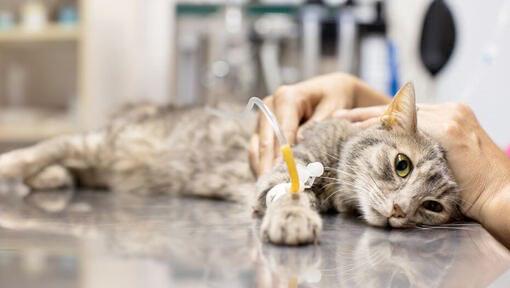
Does your cat seemed to be on the thin side even after a spay or neuter when they should have put on the feline equivalent of “the freshman 15?” The reason could be a condition known as pancreatitis.
What is Pancreatitis?
The pancreas is a vital organ, located on the right side of the abdomen next to the stomach. Pancreatitis occurs when this organ becomes inflamed. While weighing only about six to eight ounces,1
it consists of two separate parts that serve two very different vital functions for maintaining a cat’s health. The first part, the endocrine pancreas, produces various hormones. Two of the main hormones produced by the pancreas are glucagon and insulin, which regulate blood sugar levels.1 The second part, the exocrine pancreas, produces enzymes which are delivered to the intestinal tract to aid in the digestion of fats, proteins, and carbohydrates. If these enzymes become activated prematurely, they can seep into the pancreas and surrounding tissue, causing damage and inflammation.1 Cats can develop issues specific to each part of the pancreas. Diabetes mellitus is a common disorder of the endocrine pancreas, while exocrine pancreas can be affected by pancreatitis.
Inflammation of the liver and intestines may also be seen with pancreatitis. This multi-organ inflammation is sometimes referred to as ‘triaditis’. This occurs because the inflammation associated with acute pancreatitis allows digestive enzymes to spill into the abdominal cavity.2 Pancreatitis is not breed specific nor is it related to the age or sex of a cat.
This story is from the February 2024 edition of Cat Talk.
Start your 7-day Magzter GOLD free trial to access thousands of curated premium stories, and 9,000+ magazines and newspapers.
Already a subscriber ? Sign In
This story is from the February 2024 edition of Cat Talk.
Start your 7-day Magzter GOLD free trial to access thousands of curated premium stories, and 9,000+ magazines and newspapers.
Already a subscriber? Sign In

Life With Patrick
Patrick and Mount Doom

Feline Photographers Part 1
\"Cats never strike a pose that isn't photogenic.\" - Lillian Jackson Braun

The Cat Fancy Alphabet
\"The Cat Fancy Alphabet\" is a new feature in Cat Talk. It highlights various terms and aspects of the cat fancy, educating fanciers new and old about our hobby.

UP CLOSE AND Purr-sonal
If there is one person, or even just a name, that anyone in CFA (Cat Fancier Association) knows, it would have to be Allene Tartaglia. It might be from her involvement with most aspects of the operations of CFA in her position of executive director. Or perhaps from her deep involvement with both the CFA Annual meeting and/or the International Show. Cat Talk thought it was time to learn more about one of the most key people in CFA.

Vision and Hearing Dysfunctions in Senior Cats
Just as people are challenged by having deficiencies with vision and hearing over time, so are senior cats. In senior cats, pet owners may notice their cats are no longer responding to them in the same way; however, it may be difficult to figure out.

Senior Cats and House Soiling
Why is my cat no longer using its litter box? Cat soiling in the house is one of the most talked about issues for pet owners.

Nutrition for Our Senior Cats
From the time they are born, our kittens receive a tremendous amount of care, with diet being at the core of their growth and development.

Fluffy's Sixteen and STILL Plays Like a Kitten!
Enrichment for Senior Cats

Alternative Arthritis Treatments for Cats
Just like humans, cats can experience arthritis. About 90% of cats over the age of 10 years experience osteoarthritis (OA) in at least one joint.1 It is a complex condition involving inflammation and degeneration of one or more joints and is sometimes referred to as degenerative joint disease (DJD). Cats with OA experience pain and inflammation in various joints that interfere with daily activities.

Checklist For What to Look For in Your Club's Next Show Venue
Show Manager To Ring One, Please